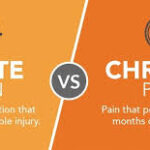Combining Painkillers with Hormonal Birth Control May Heighten Blood Clot Risk, New Study Suggests

In recent findings, commonly used pain relievers, including ibuprofen, diclofenac, and naproxen, have been associated with an increased risk of venous thromboembolism (VTE), a potentially life-threatening blood clot that can form deep within a vein, as reported by the Centers for Disease Control and Prevention (CDC). These clots can manifest in various parts of the body, such as the leg, thigh, pelvis, or arm, potentially leading to severe health complications and, in some tragic instances, even death.
Moreover, research has long-established that hormonal birth control containing both estrogen and a progestin hormone elevates the risk of developing blood clots. Estrogen, a vital sex hormone in the female reproductive system, and progestin, a synthetic form of progesterone that regulates the menstrual cycle, play pivotal roles in this heightened risk.
New Insights from a Comprehensive Study
A recently published study, featured in The BMJ journal, has expanded upon this existing body of knowledge by shedding light on the connection between nonsteroidal anti-inflammatory drugs (NSAIDs) and blood clot risk in women of childbearing age.
Lead author Amani Meaidi, MD, a postdoctoral researcher at the University of Copenhagen in Denmark, explains, “In a study involving approximately two million reproductive-aged women, we discovered that this risk was particularly pronounced in women using combined hormonal contraception [which contains both estrogen and progestin], as opposed to women using progestin-only contraceptives or no hormonal contraception at all. This suggests a possible interaction between combined hormonal contraceptives and NSAIDs.”
Balancing Risk and Occurrence
It is essential to note that, despite the heightened risk associated with both hormonal birth control and NSAIDs, the actual incidence of these blood clot events remains relatively low. Anne-Marie Amies Oelschlager, MD, a Seattle-based obstetrician-gynecologist and Chair of the American College of Obstetricians and Gynecologists (ACOG) Clinical Consensus Committee on Gynecology, underscores the overall safety of NSAIDs such as ibuprofen and naproxen for the majority of individuals. Dr. Oelschlager, who was not involved in the study, emphasizes that they are effective for managing painful periods and carry a low clotting risk.
The study found that in women not using hormonal contraception, NSAID use was associated with an additional four VTE events per week per 100,000 women. However, this risk increased to 11 additional events for women using medium-risk hormonal contraception and 23 additional events for those on high-risk hormonal contraception.
High-risk contraceptives include combined estrogen and progestin patches, vaginal rings, and pills containing 50 micrograms of estrogen. To mitigate this risk, Dr. Meaidi and her team recommend considering medium-risk or low- or no-risk birth control options.
Exploring Safer Alternatives
Medium-risk contraception encompasses all other combined oral contraceptives with less than 50 micrograms of estrogen, along with the medroxyprogesterone injection (Depo-Provera), which does not contain estrogen. Low- or no-risk alternatives include progestin-only tablets, implants, and hormone intrauterine devices (IUDs).
In addition to exploring safer birth control options, women may also wish to consult their healthcare providers about alternatives to NSAIDs. Dr. Oelschlager suggests, “Heat, exercise, and distraction can be effective for menstrual pain. Acetaminophen is another pain reliever that appears to carry a lower clotting risk and may be an option for those looking to avoid ibuprofen, naproxen, or diclofenac.”
Study Methodology and Population
The study involved a comprehensive analysis of national medical records from Denmark, covering a period from 1996 to 2017. It included data from 2,029,065 women aged 15 to 49 with no history of blood clots, cancer, hysterectomy, or fertility treatment.
Among this population, over half a million women (529,704) were using NSAIDs while on hormonal birth control. Ibuprofen was the most commonly used NSAID (60 percent), followed by diclofenac (20 percent) and naproxen (6 percent).
The study revealed that, on average, most NSAID users obtained a one-week supply of these drugs twice over a span of ten years, indicating that NSAID usage was primarily for short-term, temporary pain relief.
Over the ten-year monitoring period, 8,710 venous thromboembolic events occurred. These included 2,715 cases of pulmonary embolisms (PEs) and 5,995 cases of deep venous thromboses (DVTs). Tragically, 228 women (2.6 percent) passed away within 30 days of their diagnosis.
Is Diclofenac the Riskiest?
Notably, the study identified diclofenac as posing the highest risk, with a twofold increased likelihood of thrombosis compared to ibuprofen or naproxen. Diclofenac is considered a more potent NSAID than its counterparts and has previously been associated with a greater risk of cardiovascular disease. A previous study published in The BMJ found diclofenac to be linked to a 50 percent higher risk of cardiac arrest compared to a 31 percent greater risk associated with ibuprofen.
Morten Schmidt, MD, from Aarhus University Hospital in Denmark, suggests, “If NSAID treatment is necessary, options other than diclofenac may be preferable, especially when combined with lower-risk hormonal contraceptives such as progestin-only tablets, implants, or intrauterine devices.” Dr. Schmidt advocates for healthcare authorities and regulators to consider these research findings in their safety assessments of over-the-counter diclofenac. Additionally, women using hormonal birth control and their healthcare providers should explore alternative analgesics (painkillers) to NSAIDs.
Unraveling the Mechanisms
While the study findings imply a connection between painkillers and blood clot risk in women on hormonal birth control, they do not definitively establish causation or pinpoint the precise interaction between the two types of medications.
Meaidi postulates that these outcomes might be linked to their respective effects on the body’s coagulation (blood clotting) system. She explains, “NSAIDs are known to increase blood platelet aggregation, a phenomenon typically associated with arterial thrombosis, such as heart attacks and strokes. Oral contraceptives activate the coagulation system. However, the precise mechanism by which these two drug classes may synergistically intensify the coagulation system, thereby heightening the risk of thrombosis, remains unknown.”
Further research is required to delve deeper into the potential interplay between these two classes of drugs.
Acknowledging Limitations and Safety Measures
The authors of the study acknowledge certain limitations, including its reliance on previously recorded medical data rather than data collected from a controlled study group. The study also lacked information regarding smoking and obesity, factors that may have influenced the results.
Despite these findings, Dr. Oelschlager emphasizes that for young and healthy women, hormone birth control and NSAIDs remain generally safe and can be used together if necessary.



